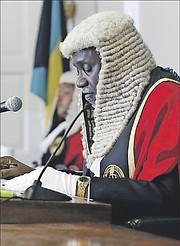By LAMECH JOHNSON
Tribune Staff Reporter
ljohnson@tribunemedia.net
THE touted Public Defender’s Office is expected to reduce some of the delays in criminal trials before the judicial system, Chief Justice Sir Hartman Longley said.
Attorney General Allyson Maynard-Gibson, QC, confirmed on Wednesday that the Office of the Public Defender, which was part of a $20m Citizen Security and Justice Programme loan facilitated by the Inter-American Development Bank (IDB), will be formally opened later this month.
Speaking at the recent opening of the 2017 Legal Year on Wednesday, Sir Hartman confirmed that office “has come on stream and it is expected that some of the delays due to unavailability of counsel will be reduced”.
“This should augur well for the system notwithstanding the fact that the original group of public defenders is relatively small. Presumably in time, additional resources will be made available to ensure the steady growth of that office,” the chief justice said.
“A protocol has been worked out with the Office of the Registrar to ensure that matters referred to the Public Defender’s Office are processed as quickly as possible given that a means test has been proposed in order to screen potential candidates. The public defenders system will operate in tandem with the system of Crown briefs which is about to undergo some revision. These changes are welcomed and they should redound to the benefit of the criminal justice system.
“There is one rider, however, which is intended to achieve greater accountability and it is that there will be a maximum fee imposed of $10,000. In any event, these improvements will lead to greater efficiency of criminal justice and should also induce senior counsel who are generally reluctant to accept Crown briefs to enter the reservoir of talent in this area,” Sir Hartman added.
During the opening of the 2015 Legal Year at the Supreme Court, Mrs Maynard-Gibson gave a report to then Chief Justice Sir Michael Barnett on a study conducted of more than three dozen delayed cases in 2014 that provided insight on why matters were not going to trial in a timely manner.
“In 2012,” she said at the 2015 sitting, “we identified four ‘escape routes’ that prevented matters coming to trial in a timely manner; unavailability of transcripts, inability to empanel juries, calendaring conflicts and lack of defence counsel.”
“In fact, of the 43 delayed trials we’ve studied in the past year to determine the key factors contributing to the problem, we’ve been able to ascertain that 47 per cent did not proceed because of the inability to empanel a jury; 21 per cent did not proceed because the virtual complainant refused to pursue the matter; 16 per cent did not proceed because defence counsel was not available to appear in court; and another 16 per cent did not proceed because the defendant was unable to secure counsel,” Mrs Maynard-Gibson had said previously.
“It is often said that awareness is the first step to recovery – and this is most certainly the case in relation to the primary causes of trial delays. So, while identifying these causes does not in and of itself solve our problem, it is fair to say that the deep understanding we now have of this challenge will allow us to develop effective policies to address it.”
The $20m Citizen Security and Justice Programme loan given by the IDB was to allow the government to “mobilise” the “public defender’s office” within the next 60 days and to help the government bring technology to bear on the justice system, with a “special focus” on the implementation of an integrated electronic system for case management, digital recording and scheduling.
The funds were also to aid in the design of a restorative justice system.
At this year’s Legal Year Opening, the attorney general said that the “use of technology has amplified the effect of closing off the escape routes.”
“Video-conferencing capacity exists in every court. And all matters between charge and trial can now be conducted by video-conference from the Department of Correctional Services at Fox Hill. This means that only persons being tried need to be brought down daily from Fox Hill to the courts on Bank Lane. The motoring public has already felt the positive effect of this change,” she said.
Mrs Maynard-Gibson also said that jurors have applauded the use of digital projection of photographs and the recent inclusion of digital projection of documents.





Comments
Use the comment form below to begin a discussion about this content.
Sign in to comment
Or login with:
OpenID